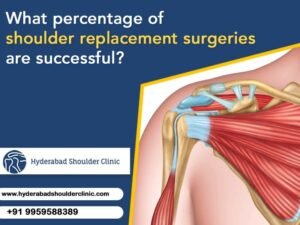A healthy shoulder means he could do a wide range of motion with his arm. However, repeated use or trauma, a fall, or an injury can be on the shoulder joint, limiting its range of motion. The patient experiences severe pain and reduced mobility. Most shoulder surgeons do not immediately jump into surgery. Many conservative treatments like applying ice, limiting the range of motion, taking rest, massages and pain medication are tried first. If none of these treatments is working, I need the patient to be unable to regain the range of motion, then the shoulder surgeon might think about shoulder replacement surgery.
At Hyderabad shoulder clinic, our team of board-certified shoulder surgeons, Dr Chandra Sekhar B, specialises in shoulder replacement surgery, including total shoulder replacement surgery and reverse shoulder replacement surgery. Our motto is to offer our patients long-term relief.
If the conservative methods are not providing pain relief, your doctor may conduct an X-ray or MRI to determine if a shoulder replacement is necessary. If you’re unsure whether a shoulder replacement is right for you, here are some important facts and five signs that it may be time to consider this treatment option.

4 conditions of shoulder replacement surgery
The shoulder anatomically consists of a ball and socket, and the ball is located at the top of the upper arm bone (humerus) and fits into the socket (glenoid). There is smooth cartilage along the lining of the socket. The cartilage facilitates the ball to move freely within the socket. Muscles, tendons, and ligaments hold the bones and cartilage together, allowing the shoulder to do a wide range of motion while keeping the joint stable. Wear and tear of the shoulder can happen due to injury or disease, leading to pain and reduced mobility. If the wear and tear of the cartilage is high, it may expose the underlying bone.
1.The range of motion gets limited.
When the range of motion gets limited, one can think of shoulder replacement. When the range of motion gets limited, it becomes difficult to perform daily tasks such as reaching overhead or combing your hair. After the surgery, the patient experiences Shoulder replacement surgery can help improve the range of motion and reduce pain.
It may be time for a shoulder replacement if you’re dealing with severe shoulder pain interfering with your daily life. Severe shoulder pain limiting daily life activities such as bathing or dressing. If nonsurgical options haven’t offered you the pain relief you need, shoulder replacement surgery may be the best option.
2. Rheumatoid Arthritis
Rheumatoid arthritis is an autoimmune disease where the body’s defence system attacks and destroys joints, including the shoulder joints. The joint suffers from chronic inflammation, and the synovial membrane that cushions the joint will thicken. It causes severe shoulder pain, one of the main causes of shoulder replacement. After the shoulder replacement surgery, the patient experiences relief from shoulder pain and helps improve the range of motion.
3. Changes in lifestyle since a serious shoulder injury
A serious shoulder injury like fractures, car accidents, and huge falls, then one should think about shoulder replacement. A serious shoulder injury means a rotator cuff tear with cartilage loss. The patient’s shoulder gets damaged, along with pain and limited range of motion. Degenerative rotator cuff tears, which occur from wear and tear over time, are very common. Experienced surgeons aim to save any rotator cuff that can be repaired. In some cases, the tear is too long-lasting, and there is muscle loss or beyond repair; the person may be a candidate for shoulder replacement. In some patients, earlier non-surgical rotator cuff repair treatment might have failed; they also may have this surgery.
4. Shoulder replacements for osteoarthritis
Osteoarthritis is a degenerative condition where the cartilage gets worn down. Cartilage helps in the smooth movement of the bones, which allows for smooth movement. Over time, the cartilage thins to a point where you have bone-on-bone arthritis. The patient complains of chronic pain in the upper arm and the front and back of the shoulder. The pain enhances while performing overhead activities. Patients also complain of clicking and catching sensation; in advanced stages, there is shoulder stiffness. After trying to cure it with nonsteroidal anti-inflammatory drugs (NSAIDs) and physical therapy to improve range of motion, shoulder replacement surgery can be considered if there is no improvement.
The procedure of Shoulder Replacement Surgery

For a traditional shoulder replacement surgery, general anaesthesia is given. An incision is made over the shoulder joint to remove the damaged cartilage from the ball and socket.
The artificial components are inserted at the appropriate locations of the shoulder joint, and the ball is attached to the upper arm bone with a metal stem. A metal, plastic cup replaces the socket (glenoid). A metal plate is used to further enhance the socket’s stability. After all the components are in place, the incision is closed. To give rest and curtail the movement of the shoulder the arm is placed in a sling.
We at Hyderabad Shoulder Clinic have years of expertise in handling various shoulder replacement surgeries. Before recommending shoulder replacement surgery, we thoroughly analyse and adopt non-surgical conservative methods. To ease the pain and increase the range of motion we recommend shoulder replacement surgery only when these treatments are not working. We perform all types of shoulder replacement surgeries, such as total shoulder replacement surgery, partial shoulder replacement surgery, or reverse shoulder replacement surgery. For more information, please visit our website Orthopedic Hospital in Hyderabad | Orthopedic Surgery | Dr Chandrashekar (hyderabadshoulderclinic.com), or contact us at +91 9959588389, shoulderandsportsclinic@gmail.com.





